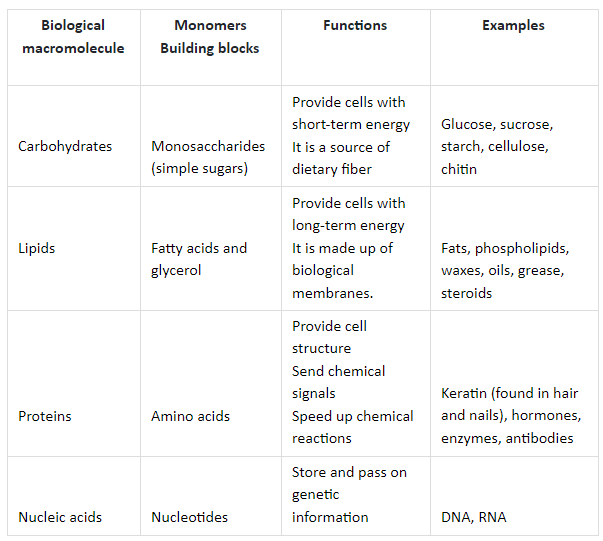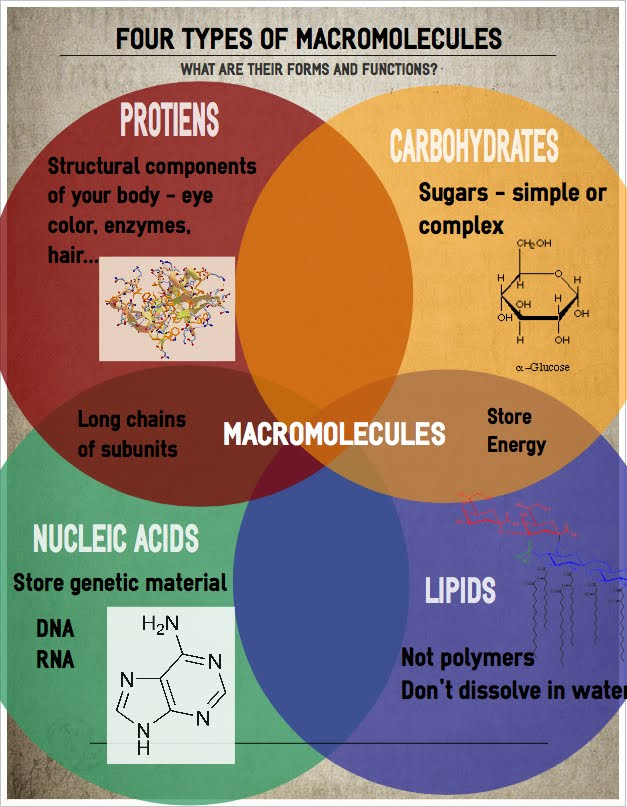Structure and Function of Biological Macromolecules Study Guide
Introduction
The large molecules required for life built from smaller organic molecules are called biological macromolecules. There are four major biological macromolecules classes: carbohydrates, lipids, proteins, and nucleic acids.Together, these molecules form the majority of a cell’s mass. Biological macromolecules are organic, as they contain carbon. In addition, they may contain hydrogen, oxygen, nitrogen, phosphorus, sulfur, and additional minor elements.
Structure and function of polymers:
The directionality of their components determines the structure and function of polymers.
-
Carbohydrates comprise linear chains of sugar monomers connected by covalent bonds. Carbohydrate polymers may be linear or branched.
-
The four elements of protein structure determine the function of a protein.The primary structure is determined by the sequential order of their constituent amino acids.
- The secondary structure resulting from the folding of the amino acid chain into elements such as alpha-helices and beta-sheets
- The tertiary structure is the overall three-dimensional shape of the protein and often minimizes free energy.
- The quaternary structure is formed from interactions between multiple polypeptide units.
- Nucleic acids have a linear sequence of nucleotides with defined ends. During the synthesis of DNA and RNA, nucleotides get added to the end of the growing strand, resulting in the formation of a covalent bond between nucleotides.
Understanding macromolecules
Biological macromolecules are very large molecules formed from polymerizing smaller molecules called monomers.
Structure and functions of biological macromolecules:
The three-dimensional structure of the biological Macromolecules influences their functioning. It is the three-dimensional shape of proteins and nucleic acids responsible for their biological activities.

1. Carbohydrates:
Carbohydrates are biological molecules made up of carbon, hydrogen, and oxygen, in a ratio of approximately one carbon atom to one water molecule. Carbohydrates get their name from this composition, and it is made up of carbon plus water.Some carbohydrates are in the form of Sugar. When people eat potatoes, they get energy or carbohydrates. Carbohydrates in potatoes are in the form of fiber, including cellulose polymers that provide structure to the potato’s cell walls.
The main functions of carbohydrates are:
a) They are a vital energy source for the cellb) provide structural support to many organismsc) Serve as receptors for cell recognition.
Biologically important carbohydrates can be categorized into three categories:
1. Monosaccharide: Gets its name from ‘Mono’ meaning ‘one’ and ‘sacchar,’ meaning ‘sugar.’ Therefore, it can be called ‘simple sugar.’ The most common example is glucose.2. Disaccharides: Gets its name from ‘Di,’ meaning ‘two.’ It is produced when two monosaccharides undergo a dehydration reaction.3. Polysaccharides: Poly means many. A long chain of monosaccharides connected by Glycosidic bonds is called polysaccharides.
2. Lipids:
Oils and fats, which may be saturated or unsaturated, are healthy and serve important functions for plants and animals. Lipids don’t make polymers.
The characteristic of lipids are:
- They have minimal or no affinity for water because it consists of mostly hydrocarbons.
- Lipids are highly diverse in function and form. Fats store a large amount of energy.
The three main types of lipids are:
- Triacylglycerols (also called Triglycerides)
- Phospholipids
- Sterols
Lipids perform these primary biological functions within the body:
a) Serve as structural components of cell membranesb) Act as energy storehousesc) Regulate hormonesd) Transmit nerve impulsese) Cholesterol formationf) Transport fat-soluble nutrients
3. Proteins:
The protein enzymes function as catalysts in cells and perform adaptable metabolism by selectively accelerating chemical reactions without consuming them.Humans have thousands of proteins, each unique or specific in function and structure. Proteins are known to have the structurally most complex molecules.
Proteins have four structures:
- Primary structure: is formed by the linear sequence of amino acids in a peptide or protein.
- Secondary structure: The hydrogen-bonding pattern determines the secondary structure of proteins. The most common types of secondary structures are the α helix and the β pleated sheet.
- Tertiary structure: interactions between the R groups of the amino acids result in the three-dimensional arrangement of the polypeptide chain in space.
- Quaternary Structure: The number and the arrangement of several protein chains or subunits into a closely packed arrangement forms this structure.
Protein’s main functions include:
a) Structural supportb) Growth and Maintenance c) Transport and storage of nutrients d) Storagee) Cellular signalingf) Movementg) Provide defense against foreign materials.
4. Nucleic acids:
There are two types of nucleic acid – DNA and RNA. DNA and RNA are the molecules that allow living organisms to pass on genetic material from generation to generation.DNA directs the RNA synthesis and controls the protein synthesis through RNA. The organisms inherit DNA from their parents.
Directionality, in molecular biology and biochemistry, is the end-to-end chemical orientation of a single strand of nucleic acid. In a single strand of DNA or RNA, the chemical convention of naming carbon atoms in the nucleotide pentose-sugar-ring means that: there will be a 5′-end, which regularly contains a phosphate group attached to the 5′ carbon of the ribose ring, and a 3′-end, which normally is unmodified from the ribose -OH substituent. DNA is always synthesized in the 5′-to-3′ direction. In other words, nucleotides are added only to the 3′ end of the growing strand.
Nucleic acids’ main functions are:
- Storage and expression of genetic information
- Physiological signaling mediators
- Secondary messengers
- Sources of energy – in the form of ATP
Conclusion
- Most of the biological nutrients are macromolecules essential for carrying out various life activities.
- Proteins, carbohydrates, lipids, and nucleic acids, are the four major macromolecules.
- They perform important functions, including providing structural support, being a source of stored fuel, storing and retrieving genetic information, and speeding biochemical reactions.
FAQs:
1. What is the structure and function of macromolecules? What are the properties of biological macromolecules?
The structure of a macromolecule is a single molecule that consists of many covalently linked subunit molecules, and a polymer is a single molecule composed of many similar monomers.
The four major macromolecules are Proteins, carbohydrates, lipids, and nucleic acids. The function of macromolecules are:
- Provide structural support
- Serve as a source of stored fuel
- To store and retrieve genetic information
- Speed biochemical reactions
2. How does the structure of biological macromolecules determine their properties and functions?
Biological macromolecules’ three-Dimensional Structure determines their functioning. Further, this three-dimensional shape of proteins and nucleic acids is responsible for their biological activities.
3. What are the functions of the four organic macromolecules?
The broad functions of the 4 organic macromolecules are:
- Proteins – Molecular Machines
- Nucleic Acids – Information Repositories
- Lipids – Waterproof Membranes
- Carbohydrates – Stored Energy
We hope you enjoyed studying this lesson and learned something cool about the Structure and Function of Biological Macromolecules! Join our Discord community to get any questions you may have answered and to engage with other students just like you! Don’t forget to download our App to experience our fun, VR classrooms – we promise, it makes studying much more fun! 😎
Sources:
- Types of Biological Macromolecules. https://courses.lumenlearning.com/introchem/chapter/types-of-biological-macromolecules. Accessed 17 Dec, 2021.
- Biological Molecules. https://opentextbc.ca/biology/chapter/2-3-biological-molecules/. Accessed 17 Dec, 2021.
- Different Types of Biological Macromolecules. https://courses.lumenlearning.com/wm-biology1/chapter/reading-biological-macromolecules/. Accessed 17 Dec, 2021.


